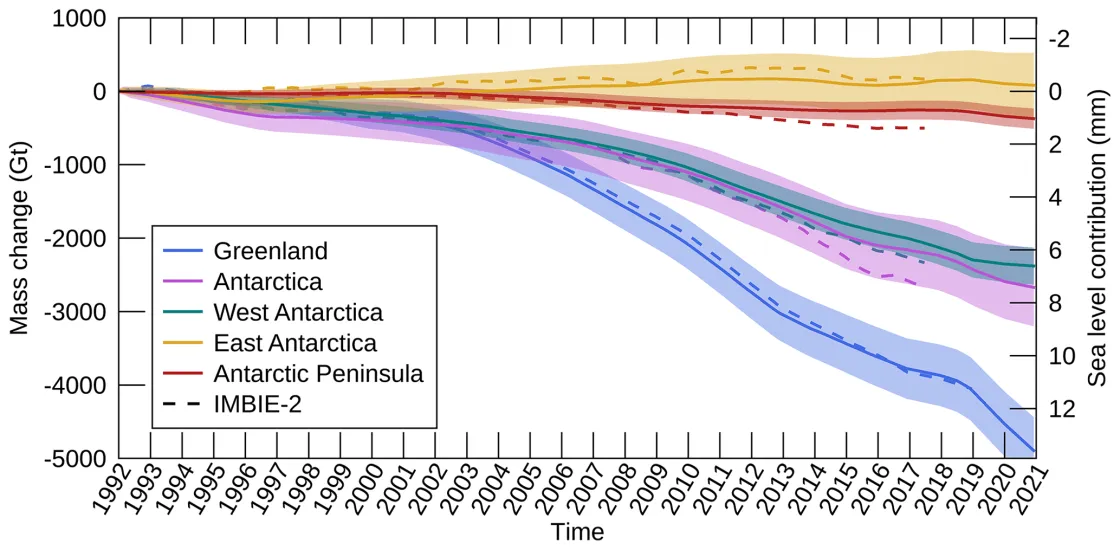NSIDC has launched an upgraded and streamlined Ice Sheets Today website. The new site replaces the site previously known as Greenland Ice Sheet Today and Antarctic Ice Sheet Today. Ice Sheets Today offers easy access to melt statistics and scientific analysis of ice sheet conditions. This overhauled website continues the stream of reliable information that NSIDC began providing in 2012.
The new Ice Sheets Today website has an updated look and feel, with responsive design that accommodates multiple screen widths.
What you can find in Ice Sheets Today
Periodic updates of ice sheet melt information: Greenland daily melt maps and graphs include the most recent full day of processed data. Antarctic melt maps and graphs are updated with each analysis post. Because Greenland and Antarctic melt seasons occur at opposite times of year, the daily statistics focus on the ice sheet currently experiencing melt.
Data tools: Data tools are currently focused on the Greenland Ice Sheet. They include an interactive melt chart that lets you compare Greenland Ice Sheet melt between years throughout the melt season or during a specific portion of the melt season. The interactive chart also provides long-term climatology information statistics. If you would like to perform your own analysis and visualize Greenland melt, you can download melt analysis spreadsheets.
Expert-produced melt analyses: NSIDC and partner scientists provide timely analyses, including overviews of current conditions, conditions in context, and discussions of related climate and weather events. NSIDC began providing analyses of the Greenland Ice Sheet in 2012 when it launched the predecessor to this website, Greenland Today. It expanded the analyses to include Antarctic Ice Sheet conditions in 2021. All the historic Greenland Today and Antarctica Today articles can be found under Monthly Analyses on the new Ice Sheets Today website.
Why ice sheets matter
During the Pleistocene Ice Ages, massive ice sheets sometimes blanketed much of North America and Eurasia. Today, just two ice sheets remain, on Greenland and Antarctica. Collectively, these ice sheets hold roughly 99 percent of Earth’s freshwater, and contain enough ice to raise sea level by an estimated 67.4 meters (223 feet) if they melted entirely.
Complete melt of either ice sheet is exceedingly unlikely in the foreseeable future. Still, even a small amount of melt from either one could reshape densely populated coastlines. This makes studying changes in ice sheet mass imperative.
Glaciologists have found, in study after study, that both of the planet’s remaining ice sheets are losing overall mass at an accelerating rate. These findings received resounding confirmation from the Ice Sheet Mass Balance Inter-comparison Exercise (IMBIE) team. IMBIE is an international collaboration of more than 80 polar scientists funded by NASA and the European Space Agency.
So far, studies by IMBIE and other parties have concluded the contribution of ice sheet loss amounts to millimeters added to global ocean sea level. That might sound trifling but the amounts are expected to rise year after year. The contributions are expected to occur in addition to other sources of rising sea level, such as mountain glacier melt and a warmer ocean increasing in volume. Ice sheet melt already contributes to nuisance flooding in low-lying coastal areas.
Sea level rise from melting ice sheets is not uniform. When an ice sheet loses mass, sea level in fact falls near the ice sheet, due to a shift in Earth’s gravitational field. Sea level rise occurs far from the ice loss. Regions expected to experience some of the fastest sea level rise, due to a combination of gravitational changes and land subsidence, include the US East Coast and Gulf Coast.
References
Clem, K.R. and M.N. Raphael, Eds. 2023: Antarctica and the Southern Ocean [in “State of the Climate in 2022“]. Bulletin of the American Meteorological Society 104(9): S322–S365. https://doi.org/10.1175/BAMS-D-23-0077.1.
Moon, T.A., R. Thoman, and M L. Druckenmiller, Eds. 2023. The Arctic [in “State of the Climate in 2022“]. Bulletin of the American Meteorological Society 104(9): S271–S321. https://doi.org/10.1175/BAMS-D-23-0079.1.
Otosaka, I.N., A. Shepherd, E.R. Ivins, N.-J. Schlegel, C. Amory, M.R. van den Broeke, M. Horwath, I. Joughin, M.D. King, G. Krinner, S. Nowicki, A. J. Payne, E. Rignot, T. Scambos, K.M. Simon, B.E. Smith, L.S. Sørensen, I. Velicogna, P. L. Whitehouse, G. A, C. Agosta, A.P. Ahlstrøm, A. Blazquez, W. Colgan, M.E. Engdahl, X. Fettweis, R. Forsberg, H. Gallée, A. Gardner, L. Gilbert, N. Gourmelen, A. Groh, B.C. Gunter, C. Harig, V. Helm, S. A. Khan, C.. Kittel, H. Konrad, P.L. Langen, B. S. Lecavalier, C.-C. Liang, B.D. Loomis, M. McMillan, D. Melini, S.-W. Seo, B. Scheuchl, E.J.O. Schrama, L. Schröder, S.B. Simonsen, T. Slater, G. Spada, T.C. Sutterley, B.D. Vishwakarma, J. Melchior van Wessem, D. Wiese, W. van der Wal, and B. Wouters. 2023. Mass balance of the Greenland and Antarctic Ice Sheets from 1992 to 2020. Earth Sytstem Science Data 15(4): 1597–1616. https://doi.org/10.5194/essd-15-1597-2023.
US Environmental Protection Agency. July 21, 2023. Climate change indicator: Ice sheets. https://www.epa.gov/climate-indicators/climate-change-indicators-ice-sheets.
